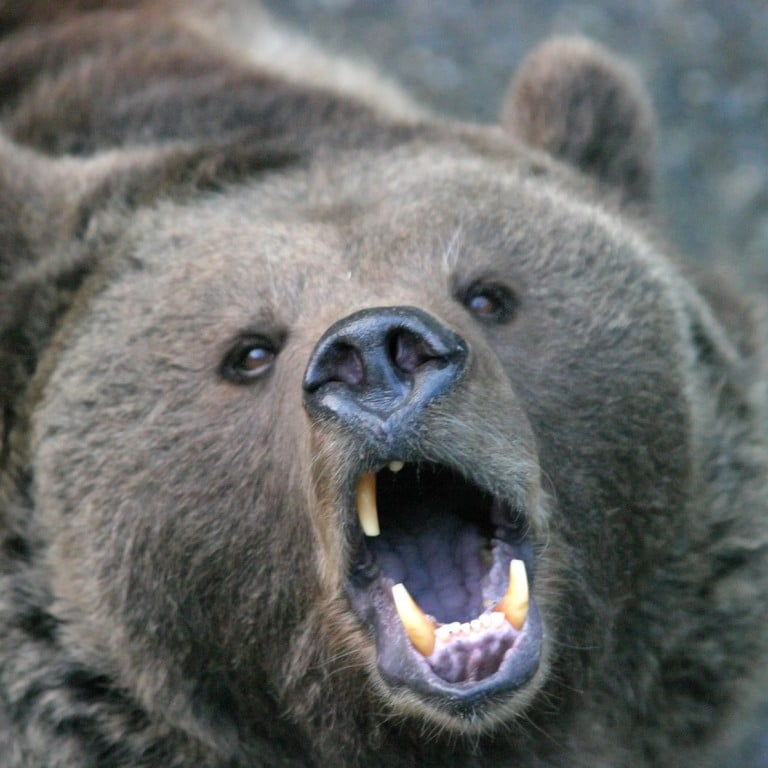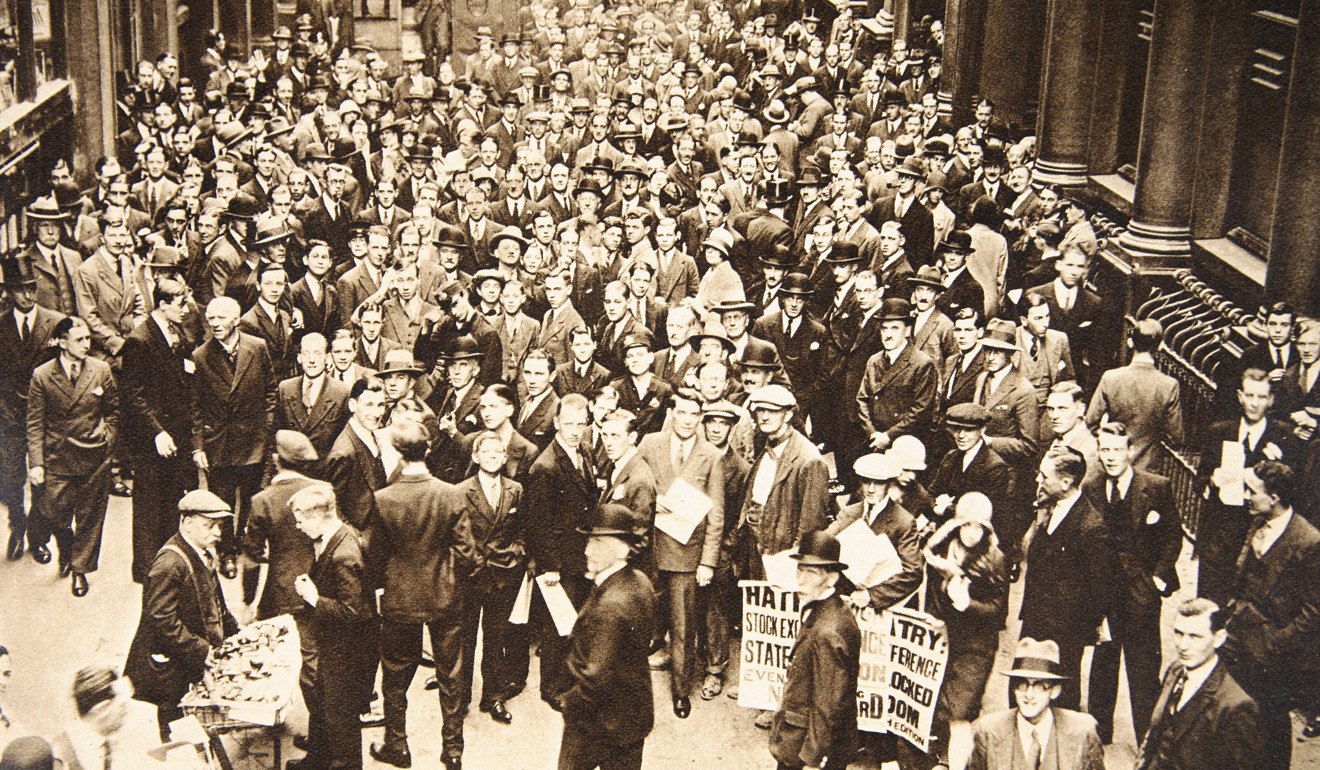
The mother of all grizzly bears is mauling global stock markets. When will she go back into hibernation?
- Dow Jones Industrial Average in US is on track for its worst month since the Great Depression
- Hang Seng has seen five 900-point drops since mid-January amid virus-sparked volatility
The mother of all grizzly bears is mauling stock portfolios around the globe.
Many investors – grappling with stocks that have been ripped to pieces in just weeks because of the coronavirus pandemic – have been left shell-shocked. Their anxious question: When will this bear go back into hibernation?
Just about everybody – from mom-and-pop investors to seasoned pros – agrees the bottom hasn’t been reached. But no one knows when it will be.
“Everyone is looking for a bottom,” said Jeffrey Halley, senior market analyst, Asia Pacific for foreign exchange company OANDA. “The coronavirus recession has the potential to be with us for a long time to come. And there is no playbook in modern times for an event like this on this scale. Not even Sars.
“Thus, we have no one-size-fits-all model for when a bottom is forming. What I’m sure we will get are many FOMO [fear of missing out] false down rallies,” he said.
Everything from stocks to commodities, including oil, to traditional safe havens, such as bonds and gold, has been smacked around by this fierce momma bear, plunging across the globe as investors frantically flee to the seeming safety of cash.
As the US mega states of California and New York led others into lockdowns, with citizens told to stay home and only essential businesses like pharmacies and grocery stores allowed to stay open, US stocks last week saw their worst week since the global financial crisis in 2008, with the S&P 500 tumbling 15 per cent.
The Dow Jones Industrial Average, meanwhile, is on track for its worst month since the Great Depression, when stocks fell a record 31 per cent in September 1931. Now, in just the first three weeks of March, the Dow is down 24.5 per cent.
In a sign of how threatening the global pandemic has become to the world’s largest economy, the Trump administration and Congress are pulling together an urgent US$1.8 trillion stimulus package to try to keep workers and businesses afloat – much larger than the US$800 billion rescue package enacted in 2009 to counter the great recession. The coronavirus package – which some analysts don’t think is even large enough – will come on top of two emergency rate cuts by the US Federal Reserve that lowered its key interest rate to near zero, while it pledged to buy US$700 billion in bonds.
“I am just overwhelmed with the amount of fear the virus has triggered in the US markets,” said American Charles Levy, an expat living in Hong Kong. “This one is possibly a once-in-a-century event, unlike Brexit or the Greek financial meltdown or even 9/11. What I see is more pain to come.”
Anticipating the virus’ spread from China to Europe and the US, the private investor began setting aside cash. Now he is buying US stocks slowly at fire-sale prices. He also sees “tremendous opportunity” in the beaten-down Australian dollar and British pound and is buying those.
Investment bank Credit Suisse said the market sell-off is not likely over, given the evolution of Covid-19, and its economic consequences.
The Swiss bank thinks it is “premature” to move into equities, as equity markets are still reacting to the pandemic situation, and the effect on underlying fundamental stock values continues to be highly uncertain. The next two-to-four weeks will be “crucial”, it said, to know if lockdowns are effective in containing the virus, and how financial markets are reacting to central banks’ stimulus measures so far.
Even after Friday’s big run-up, the financial carnage can be seen in two of Hong Kong’s most heavily traded stocks:
Since January 14, Alibaba, China’s e-commerce giant and owner of the South China Morning Post, has fallen just under 24 per cent. On Monday, it closed at HK$170, below its secondary IPO listing price of HK$176 in November.
China, where the coronavirus first broke out, is home to two major stock markets that have not tumbled into bear territory, Shanghai and Shenzhen. But Monday’s falls put them closer.
Stephen Innes, chief market strategist at AxiCorp, said he knew life had entered the “realm of the bizarre” last week when he showed up at a markets TV interview “wearing my Sunday best – only to realise I’m a day early thinking today was Friday.”
In more than a dozen interviews, Hong Kong asset managers and others had wide-ranging advice on how to wrestle a bear, from dumping weak stocks on shooting-star days to dipping back in on down days to take advantage of low prices in sectors with big dividends or excellent long-term prospects (think 5G and new economy). Others say do nothing except wait out the bear, or else you could miss out on the gains as the market begins picking back up.
How long will this bear last? Analysts’ predictions ranged from a number of months to years. The 2015 Hong Kong bear market, triggered by the meltdown in the mainland’s markets, lasted almost two years.

What’s a bear market?
A bear market begins when stocks fall 20 per cent from a recent peak.
A traditional bear market goes through four stages and is primarily caused by fear of recession, explains Morningstar columnist John Rekenthaler.
The first stage is recognition that a market downturn isn’t just a more common “correction” of 10 per cent. With the coronavirus, this stage began the last week of February in the US and lasted three weeks, he said, with huge plunges along the way.
Next comes panic, and terror-triggered selling. This is where bear markets are now – with the much-watched Dow Jones Industrial Average down 34 per cent from its peak.
This stage is followed by stabilisation, says Rekenthaler, with extreme swings both in markets and in investors’ moods. Stage 3 can last months. If this angry momma bear proves to be a traditional bear, it will enter this stage soon.
Finally, comes anticipation, says Rekenthaler, when headlines remain awful but a market recovery has, in fact, begun, even though largely invisible to weary and wary “fool-me-once” investors.
An untraditional bear market is like what happened after the bursting of dot com bubble in 2000-2002: US stocks plunged 78 per cent.
If the world is grappling with a traditional bear, contends Rekenthaler, markets will enter Stage 3 fairly soon, followed by a recovery starting in months, not years. But for that to happen, today’s endless questions about just how bad the situation will get must first be replaced by considerable certainty about what the virus’ ultimate toll will be in terms of lives lost and financial upheaval.
But this could turn out to be an unusual bear market, if, for example, the virus confounds scientists and the massive stimulus thrown at economies fails to buttress them. In that case, “all bets are off,” Rekenthaler warns.
Even if this is a traditional bear, global markets could drop another 10 per cent to 20 per cent, with the sell-off lasting until around June, says Justin Tang, head of Asian research for investment and advisory group United First Partners (UFP).
“You only know [a bottom] when it’s in your rear view mirror,” said Tang, who weathered Sars in 2003, the global financial crisis in 2008, and China’s stock market crash in 2015.
A market’s transformation from a bear – or from a bull to a bear – starts slowly and “before you know it, you’re in the thick of things,” he said.
“I’m not pretending to be able to tell you when the bottom is, but look out for qualitative indicators,” like headlines that say things like ‘Equities are dead,’” Tang said. “ … [B]asically these epidemic-led sell-offs don’t last. They basically end three-to-five months from when they start,” he said, pointing at February 19 as his start date.
Globally, disrupted supply chains, demand, international trade flows and travel, and collapsing stock prices mean that real GDP will grow only 0.7 per cent in 2020 – anything below 2 per cent is classified as a global recession – and that recovery will be slow and in U-shaped, IHS Markit economists predicted in a note Thursday.
“The rapid spread of the Covid-19 virus beyond mainland China has set the global economy up for the worst growth downturn since the 2008-09 financial crisis,” the economists wrote.
Panic breeds more panic, yet this is “just another psychological convulsion in markets based on a bad event generating ongoing fear and uncertainty,” said behavioural economist Richard Peterson, the chief executive of MarketPsych and author of Inside the Investor’s Brain: The Power of Mind over Money. “When the fear falls and uncertainty is addressed with more data … then we’ll see the end.”
With stock prices so low, this could be the opportunity of a lifetime for some investors snatch great deals out of the bear’s jaws, some analysts said.
China Asset Management, a Beijing-based money manager with US$67 billion in assets under management, says it is bullish on Hong Kong stocks, as the nearly 4 per cent dividend yield on the Hang Seng Index is a rarity.
The yield on US treasuries is less than 1 per cent, and that on China’s 10-year government bonds is around 2.5 per cent.
Tanya Gan, an algorithmic trader for investment group CLSA in Hong Kong, said the past few weeks have felt like part two of the great financial crisis.
“Having been in the markets during the GFC and seeing the recovery afterwards, this certainly looks like a once-in-a-decade – maybe longer – buying opportunity,” Gan said. “As with any investment, know your limits, do your research, and take calculated risks.”
Savvy stock watchers know that if they keep looking long enough, the momma bear will eventually show her bottom. And sometime later a bull will once again take charge.
Additional reporting by Zhang Shidong, Gigi Choy and Yujing Liu


